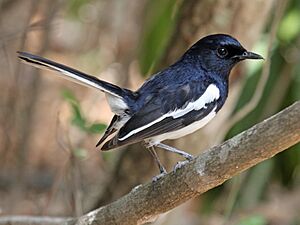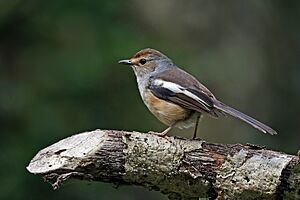Madagascar magpie-robin facts for kids
Quick facts for kids Madagascar magpie-robin |
|
|---|---|
 |
|
| Male near Isalo | |
 |
|
| Female in Montagne d'Ambre National Park; both C. a. pica | |
| Conservation status | |
| Scientific classification | |
| Genus: |
Copsychus
|
| Species: |
albospecularis
|
The Madagascar magpie-robin (its scientific name is Copsychus albospecularis) is a cool bird. It's a type of chat, which belongs to a bird family called Muscicapidae, also known as Old World flycatchers. These birds are known for their beautiful songs and often catch insects in the air.
Contents
About the Madagascar Magpie-Robin
The Madagascar magpie-robin is a close relative of the Seychelles magpie-robin and the Oriental magpie-robin. These birds might even be part of a "superspecies," meaning they are very similar and share a common ancestor. This special bird lives only in Madagascar, which means it is endemic to the island.
You can find these birds all over Madagascar, but sometimes they are spread out. They live in many different places and can be very common in some areas or quite rare in others. There are three main types, or subspecies, of the Madagascar magpie-robin. Each type lives in a slightly different part of the island.
What Does It Look Like?
The Madagascar magpie-robin is about 18 cm (7 in) long. That's about the length of a regular pencil! It weighs between 21 to 24 g (0.74–0.85 oz), which is lighter than a few quarters.
The males and females look different. The male of the most common type is all black with a bright white patch on its shoulder. The female has a grey-brown head, back, and tail. Her chest and throat are grey, and her wings and rump are a reddish-brown color. Males of the other two types have more white on their wings and a white belly. The female of one type, called C. a. pica, is much lighter in color overall.
Where Do They Live?
Madagascar magpie-robins live in almost every kind of place on the island. You can find them in dry scrubland and monsoon forest. They also live in wet humid rainforests and along the edges of forests.
They like mangrove forests and places where new trees are growing after old ones were cut down. You can even spot them in gardens and on farms that grow bananas, coffee, or eucalyptus trees. These birds live from the coast all the way up to mountains as high as 1,800 m (5,900 ft).
How Do They Behave?
What Do They Eat?
The Madagascar magpie-robin loves to eat insects. Their diet includes cockroaches, beetles, bugs, and grasshoppers. They also enjoy spiders, earthworms, small lizards, and even tiny frogs. Sometimes, they will eat berries too.
These birds usually look for food near the ground. Interestingly, males and females often look for food in slightly different ways. Females tend to search more often on the ground. Males, however, prefer to find their food higher up in the bushes and plants. Sometimes, they even join other bird species to hunt for food together in what are called "mixed-species foraging flocks."
Reproduction and Life Cycle
Madagascar magpie-robins are very territorial birds. This means that each pair defends its own area, or territory, from other birds. The size of their territory changes depending on where they live. In thick rainforests, their territories can be smaller than 1 ha (2.5 acres). In scrubland, they might defend an area as large as 6 ha (15 acres).
Their nest is shaped like a cup and is made from grasses and leaf stems. They line the inside with soft materials like rootlets, pieces of snakeskin, and even hair from lemurs or cattle. Nests are often found in holes in walls, hollow parts of tree stumps, or hidden in thick plants.
A female usually lays about three eggs, but sometimes it can be two to five. Both parents take turns sitting on the eggs for about 13 days until they hatch. Once the chicks are born, both parents feed them in the nest for about 17 days. Even after the young birds leave the nest, their parents continue to feed them for at least six more days. Young birds might stay with their parents in small groups for almost three weeks after they learn to fly. Sadly, these young birds are sometimes hunted by the Madagascar sparrowhawk.


